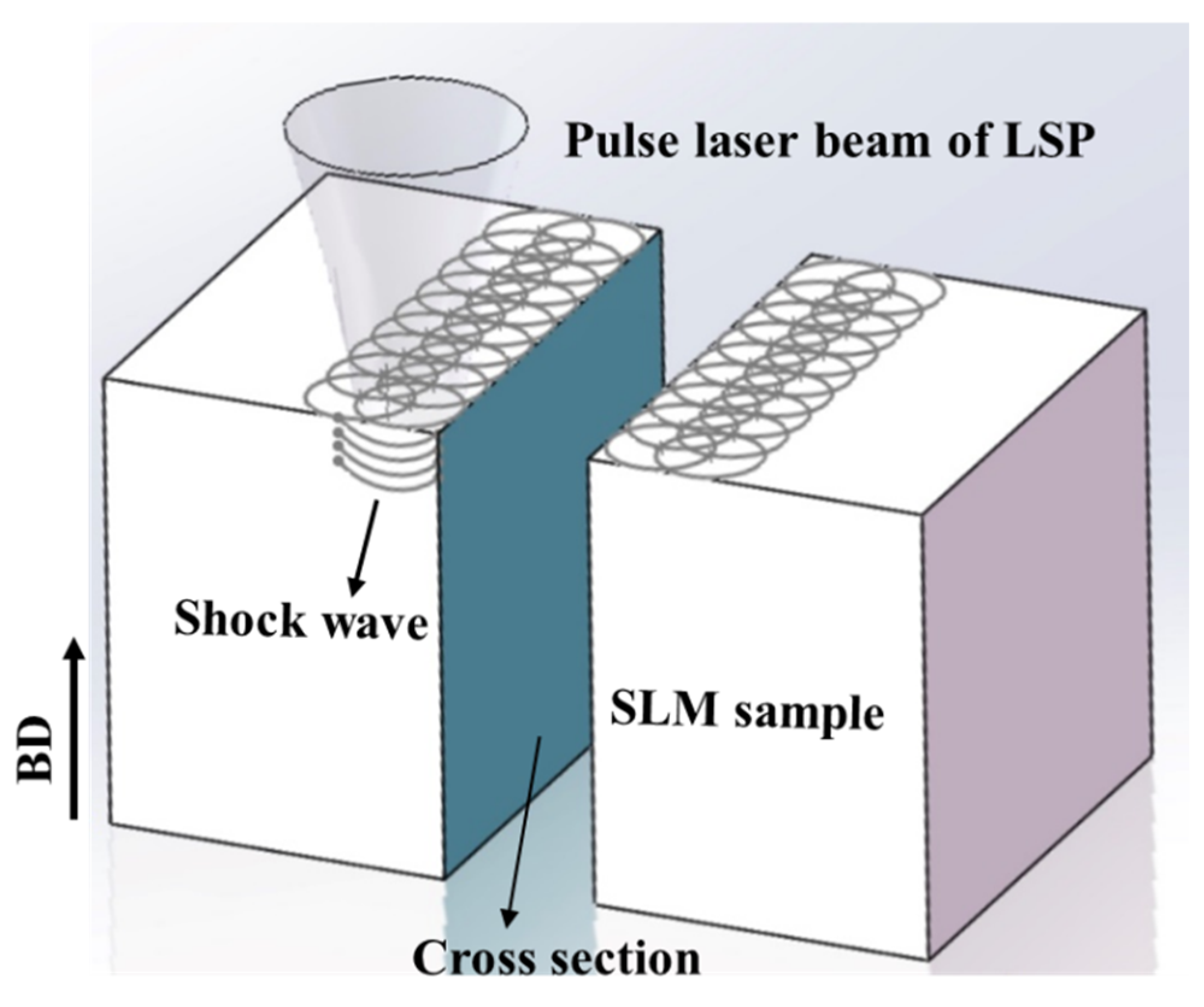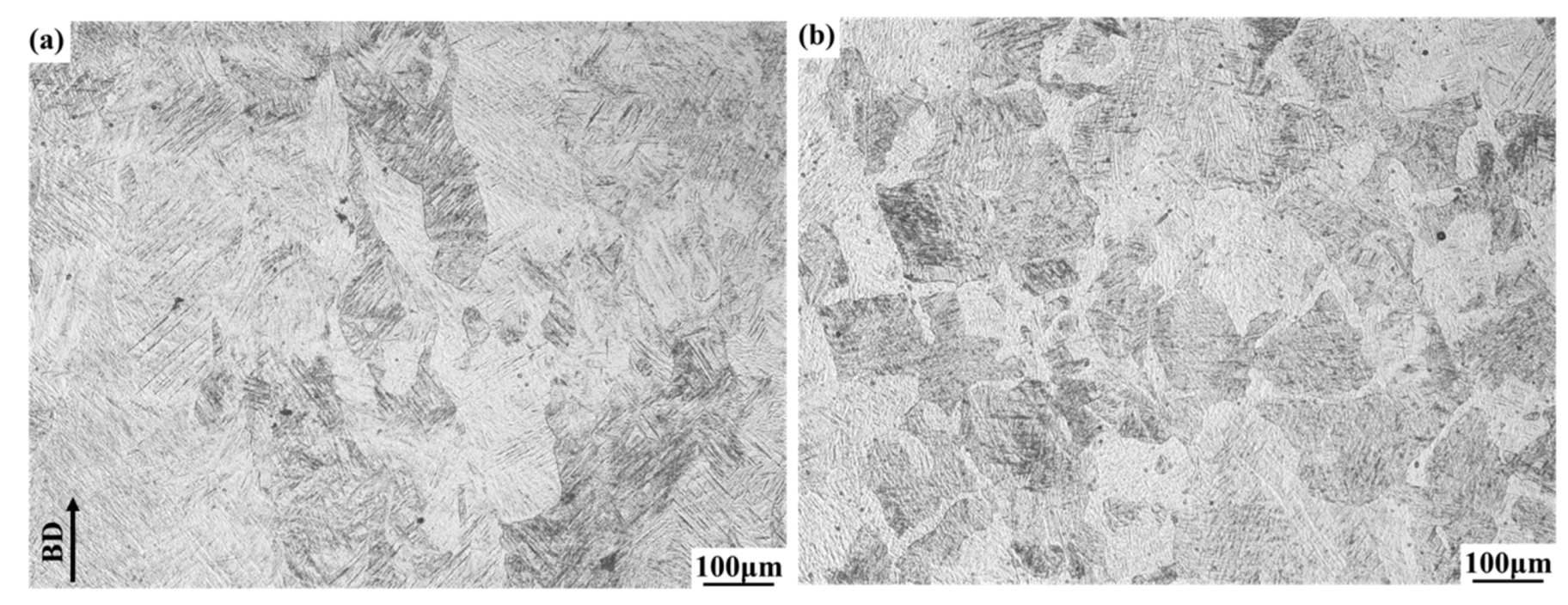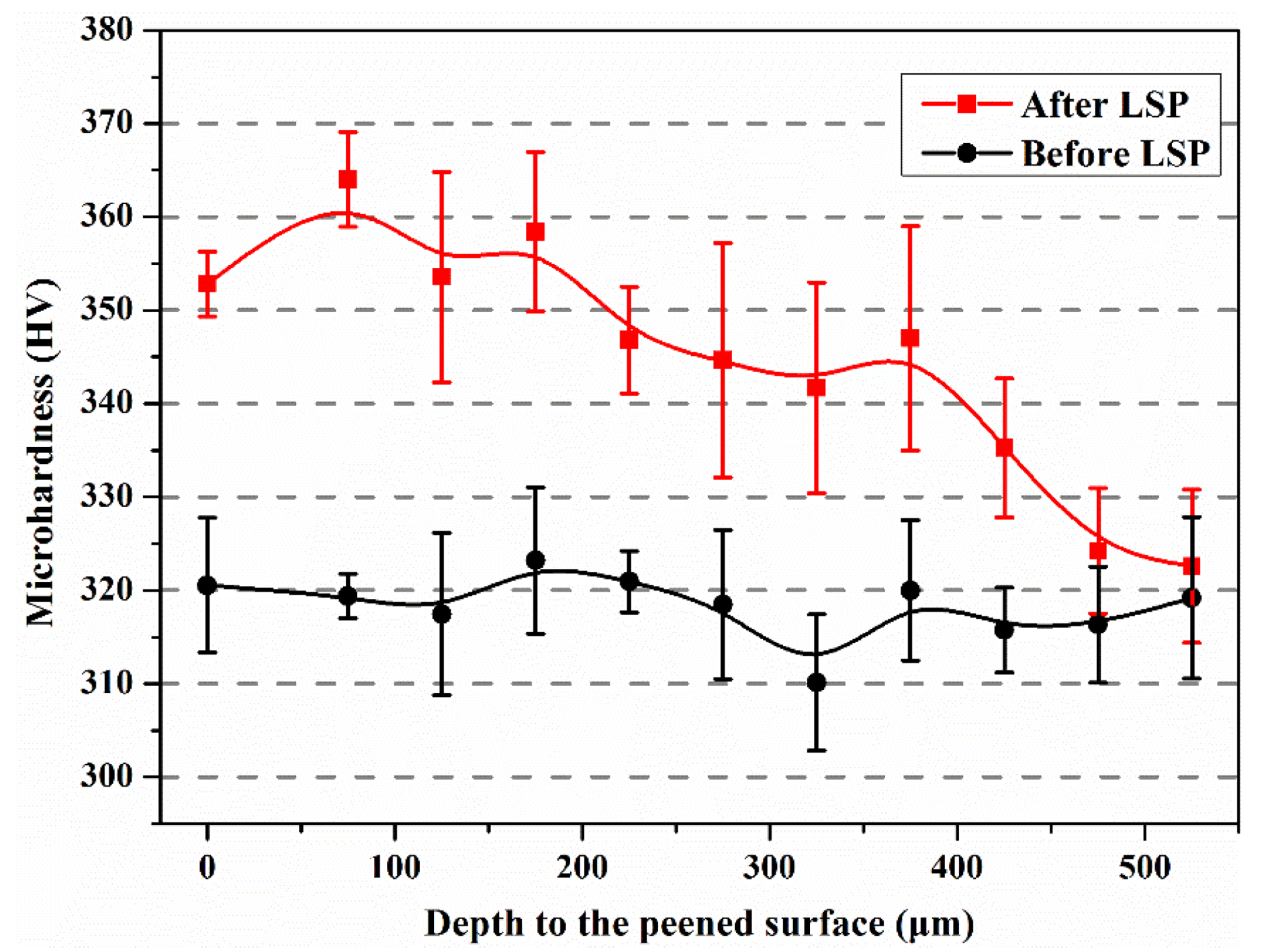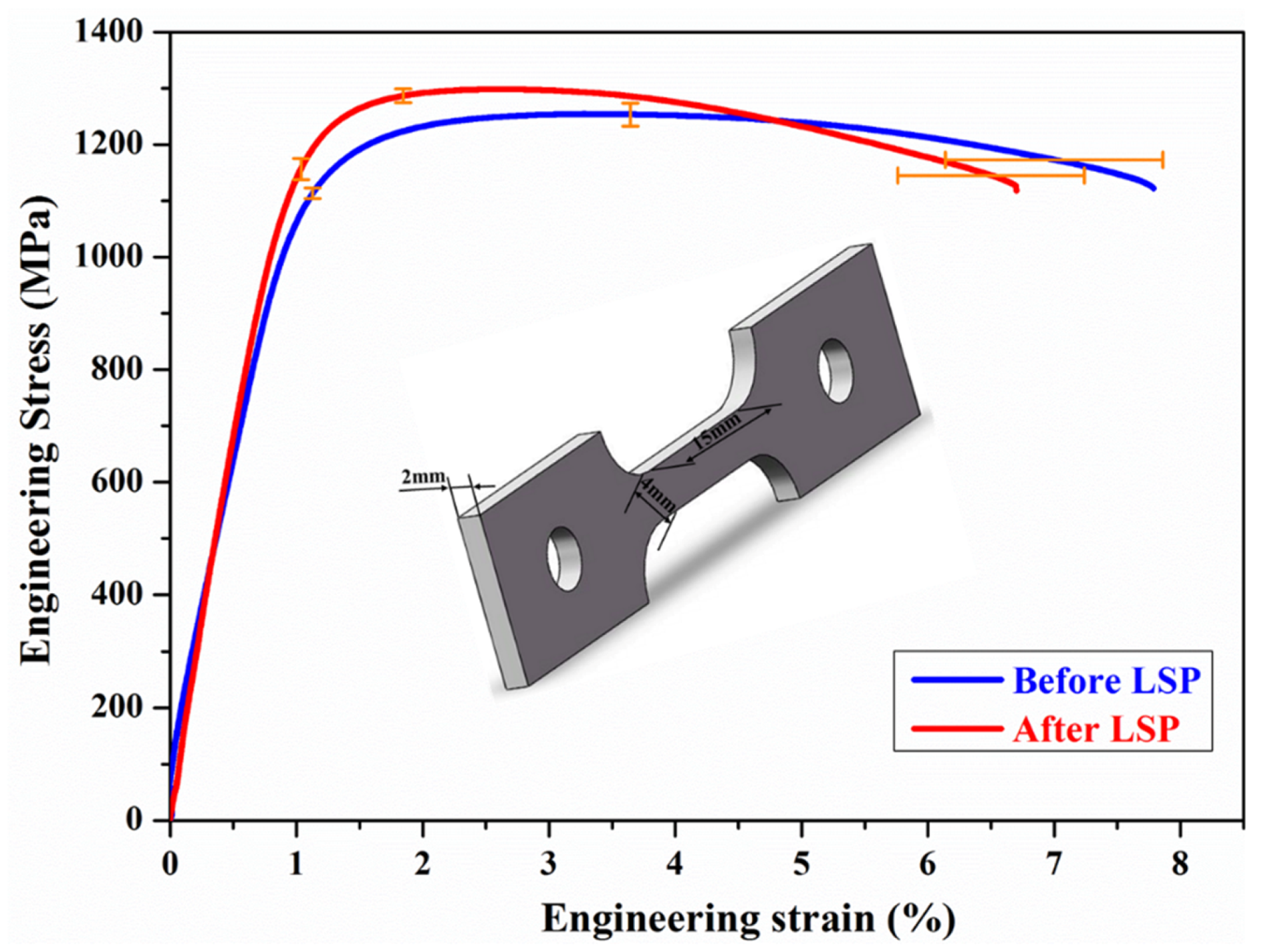Effects of Laser Shock Peening on Microstructure and Properties of Ti–6Al–4V Titanium Alloy Fabricated via Selective Laser Melting
Abstract
:1. Introduction
2. Experimental Procedures
3. Results
3.1. Microstructure Characterization
3.2. Residual Stress Distribution
3.3. Mechanical Properties
4. Discussions
4.1. Evolution of the Microstructural under LSP
4.2. Strengthening Mechanism Induced via LSP
4.3. Effect of Refined Grains on Micro-Hardness
5. Conclusions
- (1)
- The EBSD map of SLM-built Ti64 sample exhibits coarse hcp α’ martensite laths, and no β phase exists, which deviates from equilibrium microstructure at room temperature: hcp α + bcc β.
- (2)
- The LSP treatment produces CRS of maximum magnitude up to −180 MPa, and the depth of the CRS layer reaches 250 μm.
- (3)
- Grain refinement of α’ phase is ascribed to the complex interaction of dislocations and the intersection of deformation twinning after LSP.
- (4)
- The tensile strength and micro-hardness of SLM-fabricated Ti64 samples was improved after subjecting to LSP, which was attributed to the grain refinement of α’ phase and CRS.
Author Contributions
Funding
Conflicts of Interest
References
- Manero, J.M.; Gil, F.J.; Planell, J.A. Deformation Mechanisms of Ti-6Al-4V Alloy with a martensitic microstructure subjected to oligocyclic fatigue. Acta Mater. 2000, 48, 3353–3359. [Google Scholar] [CrossRef]
- Voisin, T.; Calta, N.P.; Khairallah, S.A.; Forien, J.-B.; Balogh, L.; Cunningham, R.W.; Rollett, A.D.; Wang, Y.M. Defects-dictated tensile properties of selective laser melted Ti-6Al-4V. Mater. Des. 2018, 158, 113–126. [Google Scholar] [CrossRef]
- Qian, M.; Xu, W.; Brandt, M.; Tang, H.P. Additive manufacturing and post processing of Ti-6Al-4V for superior mechanical properties. MRS Bull. 2016, 41, 775–784. [Google Scholar] [CrossRef] [Green Version]
- Wang, Y.M.; Voisin, T.; McKeown, J.; Ye, J.; Calta, N.P.; Li, Z.; Zeng, Z.; Zhang, Y.; Chen, W.; Roehling, T.T.; et al. Additively manufactured hierarchical stainless steels with high strength and ductility. Nat. Mater. 2018, 17, 63–71. [Google Scholar] [CrossRef] [PubMed] [Green Version]
- Zhang, D.; Qiu, D.; Gibson, M.A.; Zheng, Y.; Fraser, H.L.; StJohn, D.H.; Easton, M.A. Additive manufacturing of ultrafine-grained high-strength titanium alloys. Nature 2019, 576, 91–95. [Google Scholar] [CrossRef]
- Chen, C.; Xie, Y.; Yan, X.; Yin, S.; Fukanuma, H.; Huang, R.; Zhao, R.; Wang, J.; Ren, Z.; Liu, M.; et al. Effect of Hot Isostatic Pressing (HIP) on microstructure and mechanical properties of Ti-6Al-4V alloy fabricated by cold spray additive manufacturing. Addit. Manuf. 2019, 27, 595–605. [Google Scholar]
- Chen, W.; Voisin, T.; Zhang, Y.; Florien, J.-B.; Spadaccini, C.M.; McDowell, D.L.; Zhu, T.; Wang, Y.M. Microscale residual stresses in additively manufactured stainless steel. Nat. Commun. 2019, 10, 1–12. [Google Scholar] [CrossRef] [Green Version]
- Haar, G.M.T.; Becker, T.H. Selective laser melting produced Ti-6Al-4V: Post-process heat treatments to achieve superior tensile properties. Materials 2018, 11, 146. [Google Scholar] [CrossRef] [Green Version]
- Vrancken, B.; Thijs, L.; Kruth, J.-P.; van Humbeeck, J. Heat treatment of Ti-6Al-4V produced by selective laser melting: Microstructure and mechanical properties. J. Alloy Compd. 2012, 541, 177–185. [Google Scholar] [CrossRef] [Green Version]
- Colegrove, P.A.; Coules, H.E.; Fairman, J.; Martina, F.; Kashoob, T.; Mamash, H.; Cozzolino, L.D. Microstructure and residual stress improvement in wire and arc additively manufactured parts through high-pressure rolling. J. Mater. Process. Technol. 2013, 213, 1782–1791. [Google Scholar] [CrossRef]
- Leuders, S.; Meiners, S.; Wu, L.; Taube, A.; Tröster, T.; Niendorf, T. structural components manufactured by selective laser melting and investment casting impact of the process route on the damage mechanism under cyclic loading. J. Mater. Process. Technol. 2017, 248, 130–142. [Google Scholar] [CrossRef]
- Liao, Y.; Ye, C.; Cheng, G.J. A review: Warm laser shock peening and related laser processing technique. Opt. Laser Technol. 2016, 78, 15–24. [Google Scholar] [CrossRef]
- Jia, W.; Hong, Q.; Zhao, H.; Li, L.; Han, D. Effect of laser shock peening on the mechanical properties of a near-α titanium alloy. Mater. Sci. Eng. 2014, 606, 354–359. [Google Scholar] [CrossRef]
- Irizalp, S.G.; Saklakoglu, N. High strength and high ductility behavior of 6061-T6 alloy after laser shock processing. Opt. Laser Eng. 2016, 77, 183–190. [Google Scholar] [CrossRef]
- Yang, Y.; Zhang, H.; Qiao, H. Microstructure characteristics and formation mechanism of TC17 titanium alloy induced by laser shock processing. J. Alloy Compd. 2017, 722, 509–516. [Google Scholar] [CrossRef]
- Kalentics, N.; Huang, K.; de Seijas, M.O.V.; Burn, A.; Romano, V.; Logé, R. Laser shock peening: A promising tool for tailoring metallic microstructures in selective laser melting. J. Mater. Process. Technol. 2019, 266, 612–618. [Google Scholar] [CrossRef]
- Guo, W.; Sun, R.; Song, B.; Zhu, Y.; Li, F.; Che, Z.; Li, B.; Guo, C.; Liu, L.; Peng, P. Laser shock peening of laser additive manufactured Ti6Al4V titanium alloy. Surf. Coatings Technol. 2018, 349, 503–510. [Google Scholar] [CrossRef]
- Jin, X.; Lan, L.; Gao, S.; He, B.; Rong, Y. Effects of laser shock peening on microstructure and fatigue behavior of Ti–6Al–4V alloy fabricated via electron beam melting. Mater. Sci. Eng. 2020, 780, 139–199. [Google Scholar] [CrossRef]
- Yang, J.; Yu, H.; Yin, J.; Gao, M.; Wang, Z.; Zeng, X. Formation and control of martensite in Ti-6Al-4V alloy produced by selective laser melting. Mater. Des. 2016, 108, 308–318. [Google Scholar] [CrossRef]
- Zhu, X.; Zhou, M.; Dai, Q.; Cheng, G.J. Deformation modes in stainless steel during laser shock peening. j. manuf. sci. eng. 2009, 131, 5. [Google Scholar] [CrossRef]
- Liu, Y.; Qin, S.; Zhang, J.; Wang, Y.; Rong, Y.; Zuo, X.; Chen, N. Influence of transformation plasticity on the distribution of internal stress in three water-quenched cylinders. Met. Mater. Trans. 2017, 48, 4943–4956. [Google Scholar] [CrossRef]
- Kalenticsa, N.; Boillata, E.; Peyreb, P.; Gorny, C.; Kenel, C.; Leinenbach, C.; Jhabvala, J.; Logé, R.E. 3D laser shock peening—A new method for the 3D control of residual stresses in selective laser melting. Mater. Des. 2017, 130, 350–356. [Google Scholar] [CrossRef] [Green Version]
- Lan, L.; Jin, X.; Gao, S.; He, B.; Rong, Y. Microstructural evolution and stress state related to mechanical properties of electron beam melted Ti–6Al–4V alloy modified by laser shock peening. J. Mater. Sci. Technol. 2020, 50, 153–161. [Google Scholar] [CrossRef]
- Peyre, P.; Fabbro, R.; Merrien, P.; Lieurade, H. Laser shock processing of aluminium alloys. application to high cycle fatigue behaviour. Mater. Sci. Eng. 1996, 210, 102–113. [Google Scholar] [CrossRef]
- Multigner, M.; Frutos, E.; Mera, C.; Chao, J.; González-Carrasco, J.L. Interrogations on the sub-surface strain hardening of grit blasted Ti-6Al-4V alloy. Surf. Coatings Technol. 2009, 203, 2036–2040. [Google Scholar] [CrossRef]
- Oh, J.-M.; Lim, J.-W.; Lee, B.-G.; Suh, C.-Y.; Cho, S.-W.; Lee, S.-W.; Choi, G.-S. Grain refinement and hardness increase of titanium via trace element addition. Mater. Trans. 2010, 51, 2009–2012. [Google Scholar] [CrossRef] [Green Version]
- Sun, R.; Li, L.; Zhu, Y.; Guo, W.; Peng, P.; Cong, B.; Sun, J.; Che, Z.; Li, B.; Guo, C.; et al. Microstructure, residual stress and tensile properties control of wire-arc additive manufactured 2319 aluminum alloy with laser shock peening. J. Alloy Compd. 2018, 747, 255–265. [Google Scholar] [CrossRef]
- Leyens, C.; Peters, M. Titanium and Titanium Alloys: Fundamentals and Applications; John Wiley & Sons: Weinheim, Germary, 2003. [Google Scholar]
- Bridier, F.; Villechaise, P.; Mendez, J. Analysis of the different slip systems activated by tension in a α/β titanium alloy in relation with local crystallographic orientation. Acta Mater. 2005, 53, 555–567. [Google Scholar] [CrossRef]
- Meyers, M.A.; Vöhringer, O.; Lubarda, V. The Onset of twinning in metals: A constitutive description. Acta Mater. 2001, 49, 4025–4039. [Google Scholar] [CrossRef]
- Yin, F.; Cheng, G.J.; Xu, R.; Zhao, K.; Li, Q.; Jian, J.; Hu, S.; Sun, S.; An, L.; Han, Q. Ultrastrong nanocrystalline stainless steel and its hall-petch relationship in the nanoscale. Scr. Mater. 2018, 155, 26–31. [Google Scholar] [CrossRef]
- Di Schino, A.; Kenny, J. Grain refinement strengthening of a micro-crystalline high nitrogen austenitic stainless steel. Mater. Lett. 2003, 57, 1830–1834. [Google Scholar] [CrossRef]
- Tong, Z.; Ren, X.; Ren, Y.; Dai, F.; Ye, Y.; Zhou, W.; Chen, L.; Ye, Z. Effect of laser shock peening on microstructure and hot corrosion of TC11 alloy. Surf. Coatings Technol. 2018, 335, 32–40. [Google Scholar] [CrossRef]








| Composition | Al | V | Fe | N | O | H | Ti |
|---|---|---|---|---|---|---|---|
| Mass fraction/% | 6.2 | 3.89 | 0.17 | 0.002 | 0.091 | 0.002 | Bal. |
| Ti64 Samples | Before LSP | After LSP |
|---|---|---|
| UTS/MPa | 1253.3 ± 20.54 | 1286.7 ± 12.48 |
| YS/MPa | 1113.3 ± 9.43 | 1156.7 ± 18.86 |
| El/% | 7.0 ± 0.86 | 6.5 ± 0.74 |
© 2020 by the authors. Licensee MDPI, Basel, Switzerland. This article is an open access article distributed under the terms and conditions of the Creative Commons Attribution (CC BY) license (http://creativecommons.org/licenses/by/4.0/).
Share and Cite
Lan, L.; Xin, R.; Jin, X.; Gao, S.; He, B.; Rong, Y.; Min, N. Effects of Laser Shock Peening on Microstructure and Properties of Ti–6Al–4V Titanium Alloy Fabricated via Selective Laser Melting. Materials 2020, 13, 3261. https://doi.org/10.3390/ma13153261
Lan L, Xin R, Jin X, Gao S, He B, Rong Y, Min N. Effects of Laser Shock Peening on Microstructure and Properties of Ti–6Al–4V Titanium Alloy Fabricated via Selective Laser Melting. Materials. 2020; 13(15):3261. https://doi.org/10.3390/ma13153261
Chicago/Turabian StyleLan, Liang, Ruyi Xin, Xinyuan Jin, Shuang Gao, Bo He, Yonghua Rong, and Na Min. 2020. "Effects of Laser Shock Peening on Microstructure and Properties of Ti–6Al–4V Titanium Alloy Fabricated via Selective Laser Melting" Materials 13, no. 15: 3261. https://doi.org/10.3390/ma13153261





